Your hallway is more than just a passage to other rooms—it’s the first impression guests have of your home and a space you traverse multiple times a day. With all these considerations, it’s important to choose the right flooring that combines durability, aesthetics, and functionality. And who better to guide you through this than Wood and Beyond, a UK-based expert in Hardwood, Engineered Wood, Laminate, and Luxury Vinyl Flooring. Our comprehensive guide covers everything from durability to the latest trends, ensuring you make an informed decision tailored to your home’s unique needs.
Table of Contents
- What Are the Most Durable Materials for Hallway Flooring?
- How Do Hallways Differ from Other Rooms in Terms of Flooring Needs?
- What Are the Best Flooring Options for Homes with Pets and Children?
- How Do You Maintain Different Types of Hallway Flooring?
- What Are the Costs Associated with Various Types of Hallway Flooring?
- How Do Climate and Humidity Affect Hallway Flooring Choices?
- What Is the Lifespan of Different Hallway Flooring Options?
- How Do I Choose Flooring Material Based on Foot Traffic in the Hallway?
- What Is the Installation Process Like for Different Types of Flooring?
- Can I Use Underfloor Heating With All Types of Hallway Flooring?
- How Do Design and Aesthetics Come Into Play?
- What Are the Latest Trends in Hallway Flooring?
What Are the Most Durable Materials for Hallway Flooring?
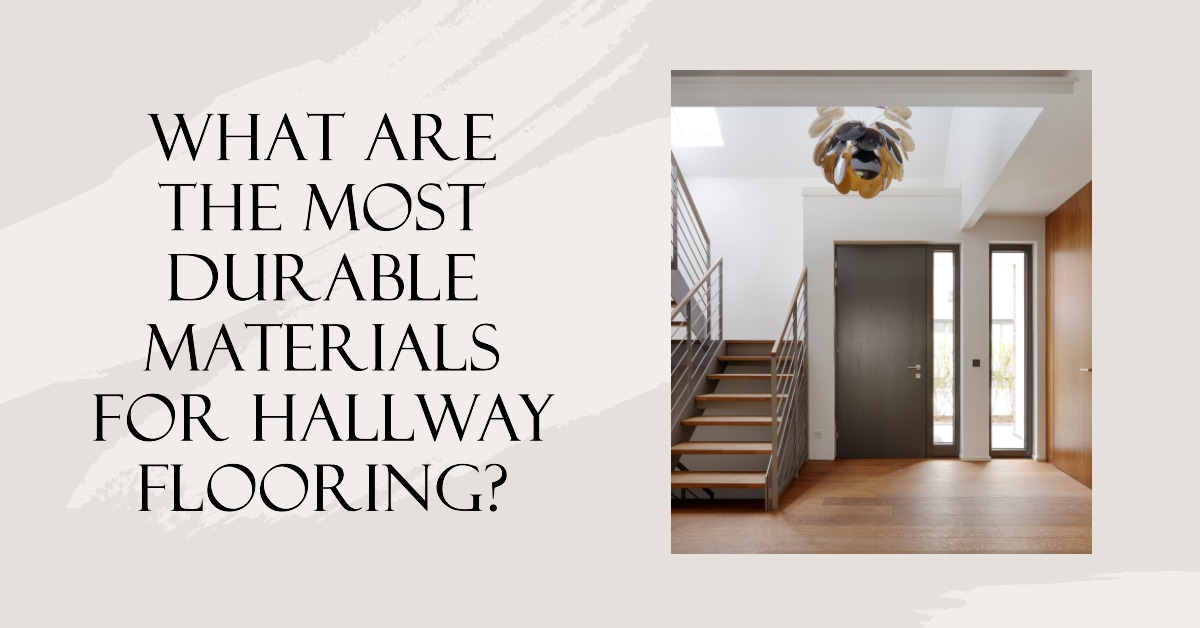
Hallways are high-traffic areas in any home. Choosing a durable flooring material is imperative to ensure longevity and to maintain aesthetics. Here are some key points to consider:
- Hardwood: Hardwood flooring is a classic choice for hallways and is highly durable. Oak, maple, and hickory are among the hardest wood species and can withstand heavy traffic.
- Engineered Wood: This is composed of a top layer of solid wood and layers of plywood underneath. Engineered wood flooring is less susceptible to changes in humidity and temperature.
- Laminate: This is a cost-effective and durable option that imitates the look of natural materials like wood or stone. High-pressure laminate flooring is particularly resistant to wear and tear.
- Vinyl: Luxury Vinyl Tiles (LVT) are incredibly resilient and can mimic the appearance of wood and stone. They are easy to clean and maintain.
- Tile: Ceramic and porcelain tiles are both attractive and durable options. However, they can be cold underfoot and may require a heating system for added comfort.
- Stone: Natural stone such as granite, marble, and slate offer unparalleled durability but come at a higher cost.
- Carpet: While comfortable, carpets are generally less durable and can be challenging to maintain in high-traffic areas.
- Material Combinations: Combining materials like hardwood with tile inlays can create visual interest while allowing for strategic durability.
- Finish and Sealant: Whichever material you choose, ensure it is treated with a durable finish or sealant to enhance its life span.
- Sustainability: Consider environmentally friendly options like bamboo or cork, though they may be less durable than hardwood or stone.
| Flooring Type | Durability Rating | Pros | Cons |
|---|---|---|---|
| Hardwood | Moderate | Can be refinished multiple times | Susceptible to scratches |
| Engineered Wood | Moderate-High | Resistant to moisture, more stable than hardwood | Limited refinishing options |
| Laminate | High | Scratch-resistant and easy to clean | Cannot be refinished |
| Vinyl (LVT) | High | Water-resistant, scratch-resistant | Can dent under heavy furniture |
| Tile | Very High | Extremely durable, water-resistant | Cold and hard underfoot |
| Stone | Very High | Natural durability, unique aesthetic | Requires sealing, expensive |
| Carpet | Low-Moderate | Comfortable underfoot | Shows wear and tear, stains |
| Cork | Moderate | Soft and resilient | Can dent, sensitive to moisture |
| Bamboo | High | Eco-friendly, durable | Sensitive to humidity changes |
| Rubber | Very High | Excellent durability, impact resistance, easy to clean | Limited aesthetic appeal |
How Do Hallways Differ from Other Rooms in Terms of Flooring Needs?
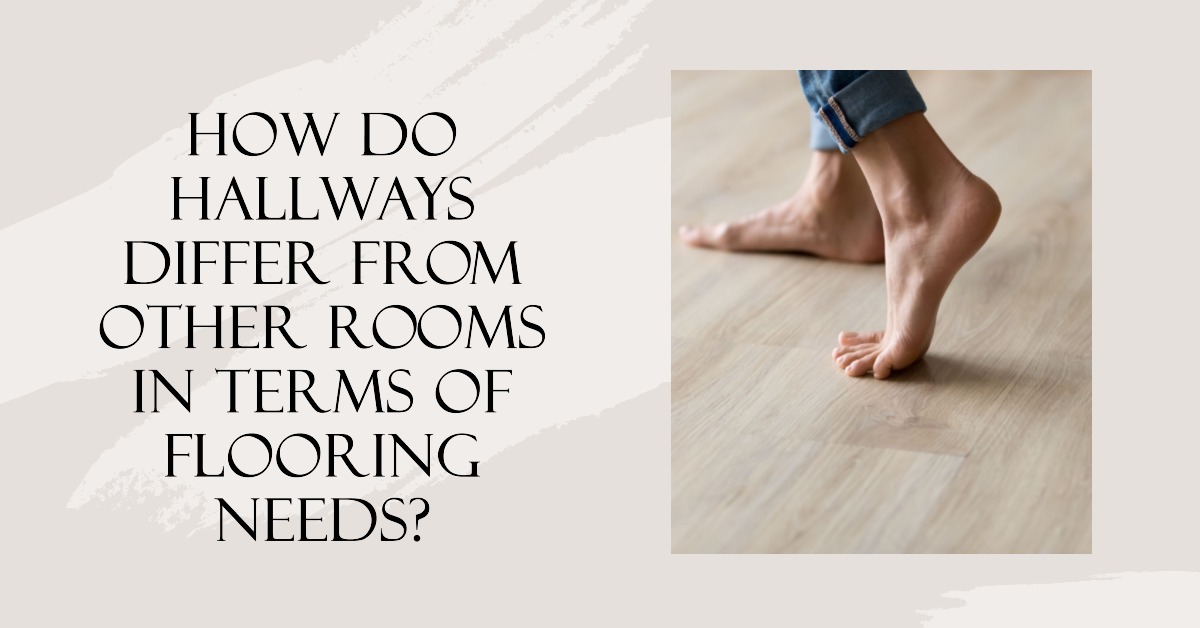
Hallways act as transitional spaces connecting various rooms, so their flooring requirements are unique.
- Traffic: Unlike rooms that are occupied for extended periods, hallways see more frequent but brief foot traffic.
- Moisture: Hallways near entrances are prone to moisture and may require water-resistant flooring.
- Width: Hallways are often narrower than other rooms, influencing the visual aspect of the flooring.
- Length: The length of the hallway can affect how patterns and lines in the flooring material appear, either elongating the space or making it appear shorter.
- Lighting: Natural light exposure is generally limited in hallways, so lighter flooring options may help brighten the space.
- Acoustics: Noise can echo in hallways. Materials like carpet or cork can provide acoustic insulation.
- Temperature: With less sun exposure and possibly fewer heating vents, hallways can be colder, influencing the choice of flooring.
- Aesthetics: The hallway flooring should complement the flooring in adjacent rooms for a cohesive look.
- Maintenance: Given the high-traffic nature, easy-to-clean flooring options are generally preferable.
- Budget: Hallways usually require less material than larger rooms, potentially allowing for higher-end options.
| Criteria | Hallway | Other Rooms | Notes |
|---|---|---|---|
| Traffic Level | High | Variable | Hallways experience more foot traffic, requiring more durable flooring options |
| Moisture Exposure | Low | Variable (High in bathrooms) | Hallways are less likely to encounter moisture compared to bathrooms or kitchens |
| Aesthetic Importance | Moderate | High | Hallways are less of a focal point than living rooms or bedrooms |
| Comfort | Less Critical | More Critical | Comfort may be sacrificed for durability in hallways |
| Installation Complexity | Moderate-High | Low-Moderate | Hallways may have more corners and require more cuts |
| Budget Constraints | Moderate | Variable | Consumers may opt for less expensive but durable options for hallways |
| Need for Sound Insulation | Low | Moderate-High | Noise is less of a concern in hallways compared to bedrooms or media rooms |
| Light Exposure | Variable | Variable | Choice of material may be influenced by the amount of natural light available |
| Maintenance | High | Moderate | Higher traffic necessitates more frequent cleaning or maintenance |
| Underfloor Heating Compatibility | Variable | Variable | Not all materials are suitable for underfloor heating |
What Are the Best Flooring Options for Homes with Pets and Children?
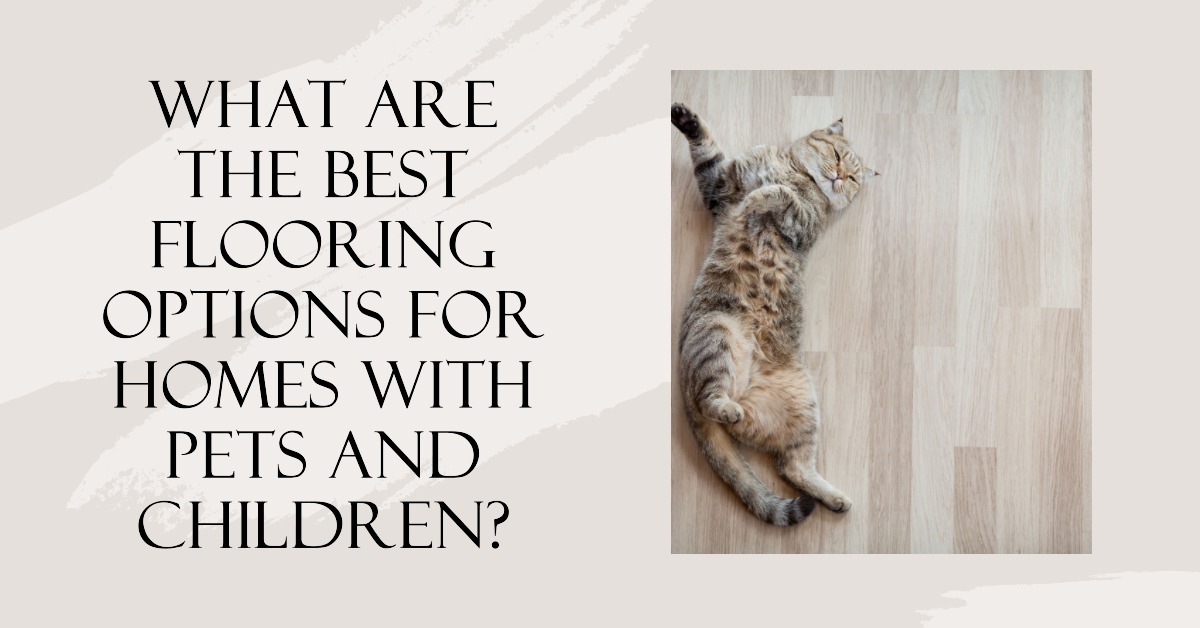
When choosing flooring for hallways in homes with pets and children, certain criteria become especially critical. Here’s how different flooring options measure up:
- Hardwood: Hardwood is a good option, but it can be susceptible to scratches from pet nails. Opt for a hardwood species known for its hardness, like Brazilian cherry.
- Engineered Wood: Engineered wood is a practical alternative to hardwood, offering durability and scratch resistance, especially those with thicker wear layers.
- Laminate: Highly scratch-resistant and easy to clean, making it an excellent choice for homes with pets and young children.
- Vinyl: Luxury Vinyl Tiles (LVT) are resistant to moisture and easy to clean. They are also softer underfoot, offering a cushioning effect.
- Tile: Ceramic and porcelain tiles are extremely durable but can be hard and cold, which may not be ideal for children or pets.
- Stone: Similar to tile, but with an even higher durability. However, it can be very cold and hard underfoot.
- Carpet: Provides a soft surface for children to play on and offers cushioning in case of falls. However, it can be a magnet for pet hair and difficult to clean.
- Cork: Offers a natural resistance to microbes and is also soft underfoot. However, it may be susceptible to scratches.
- Bamboo: An eco-friendly option that is harder than some types of hardwood. However, it is prone to scratches and dents.
- Rubber: Often overlooked, but provides a durable and soft surface. Excellent for reducing noise and easy to maintain.
| Flooring Type | Scratch Resistance | Comfort | Maintenance | Suitability for Pets and Children |
|---|---|---|---|---|
| Hardwood | Medium | High | Medium | Moderate |
| Engineered Wood | High | High | Medium | High |
| Laminate | High | Medium | Easy | High |
| Vinyl (LVT) | High | High | Easy | High |
| Tile | High | Low | Easy | Low |
| Stone | High | Low | Medium | Low |
| Carpet | Low | High | Difficult | Moderate |
| Cork | Medium | High | Medium | Moderate |
| Bamboo | Medium | Medium | Medium | Moderate |
| Rubber | High | High | Easy | High |
How Do You Maintain Different Types of Hallway Flooring?
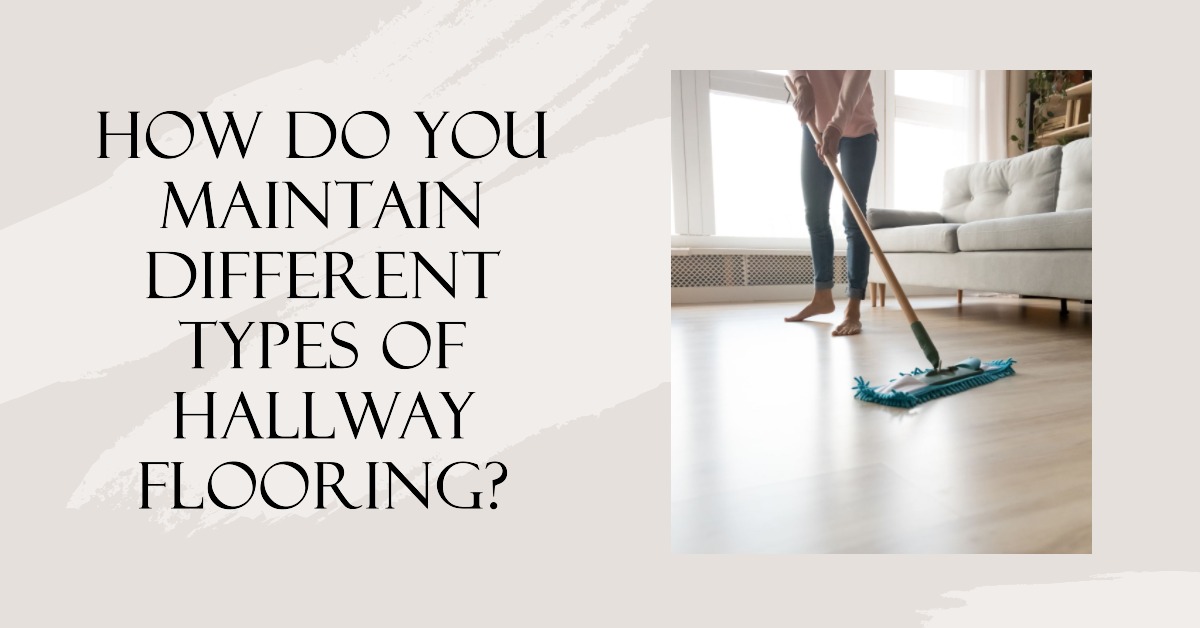
Maintaining the beauty and integrity of your hallway flooring is paramount. Here are some tailored maintenance tips for various flooring types:
- Hardwood: Requires periodic refinishing and is best cleaned with a damp mop and specialised wood cleaner.
- Engineered Wood: Similar to hardwood but usually doesn’t require as frequent refinishing. Use a dry or damp mop for cleaning.
- Laminate: Should be cleaned with a dry mop to avoid moisture seeping into the seams. A laminate cleaner can also be used for deeper cleaning.
- Vinyl (LVT): Can be mopped with a mild detergent and is also suitable for steam cleaning.
- Tile: Sweeping and occasional mopping with a mild detergent are usually sufficient. Grout may require separate cleaning.
- Stone: Must be sealed periodically to maintain its appearance and resistance to moisture. Use a pH-neutral cleaner for routine cleaning.
- Carpet: Requires regular vacuuming and periodic deep cleaning through professional carpet cleaning services.
- Cork: Should be swept or vacuumed regularly. Clean with a damp mop and a mild detergent.
- Bamboo: Similar in maintenance to hardwood, needing periodic refinishing and cleaning with a damp mop.
- Rubber: Simply sweep or vacuum and mop with a mild detergent.
| Flooring Type | Daily Cleaning | Periodic Maintenance |
|---|---|---|
| Hardwood | Damp Mop | Refinishing |
| Engineered Wood | Damp Mop | Light Sanding/Sealing |
| Laminate | Dry Mop | None |
| Vinyl (LVT) | Wet Mop | None |
| Tile | Wet Mop | Grout Cleaning |
| Stone | Wet Mop | Sealing |
| Carpet | Vacuum | Professional Cleaning |
| Cork | Damp Mop | Sealing |
| Bamboo | Damp Mop | Refinishing |
| Rubber | Wet Mop | None |
What Are the Costs Associated with Various Types of Hallway Flooring?
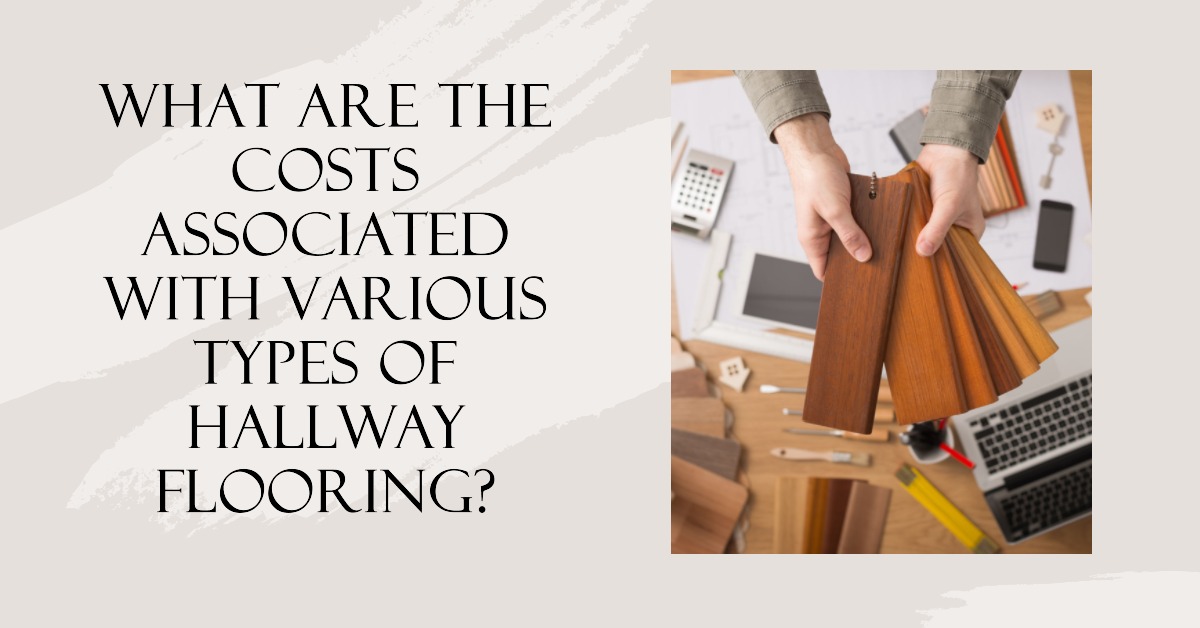
Understanding the costs involved in selecting a flooring option is crucial for making an informed decision. Below are some factors and estimated price ranges for various flooring types:
- Hardwood: Cost varies significantly depending on the species. Expect to pay between £40 to £100 per square metre. Installation can add another £10 to £20 per square metre.
- Engineered Wood: Generally cheaper than hardwood, ranging from £25 to £70 per square metre, plus £10 to £15 per square metre for installation.
- Laminate: One of the most budget-friendly options, priced between £10 to £30 per square metre. Installation is relatively easier, adding around £5 to £10 per square metre.
- Vinyl (LVT): Costs can range from £15 to £40 per square metre, with installation costing an additional £5 to £10 per square metre.
- Tile: Ceramic tiles start at around £10 per square metre, whereas premium porcelain can go up to £50. Installation can cost between £10 to £20 per square metre.
- Stone: This is generally the most expensive option, with prices starting at £50 and going up to £200 per square metre. Installation costs can also be high, sometimes exceeding £30 per square metre.
- Carpet: Costs range from £5 to £30 per square metre. Professional installation can add an additional £5 to £10 per square metre.
- Cork: Prices range from £20 to £40 per square metre, with an additional £5 to £10 per square metre for installation.
- Bamboo: Ranges between £25 to £50 per square metre, plus £10 to £20 per square metre for installation.
- Rubber: Costs around £20 to £40 per square metre, with minimal installation costs due to its DIY-friendly nature.
| Flooring Type | Material Cost (£/sqm) | Installation Cost (£/sqm) | Total Estimated Cost (£/sqm) |
|---|---|---|---|
| Hardwood | £40 – £100 | £10 – £20 | £50 – £120 |
| Engineered Wood | £25 – £70 | £10 – £15 | £35 – £85 |
| Laminate | £10 – £30 | £5 – £10 | £15 – £40 |
| Vinyl (LVT) | £15 – £40 | £5 – £10 | £20 – £50 |
| Tile | £10 – £50 | £10 – £20 | £20 – £70 |
| Stone | £50 – £200 | £20 – £30 | £70 – £230 |
| Carpet | £5 – £30 | £5 – £10 | £10 – £40 |
| Cork | £20 – £40 | £5 – £10 | £25 – £50 |
| Bamboo | £25 – £50 | £10 – £20 | £35 – £70 |
| Rubber | £20 – £40 | Minimal | £20 – £45 |
How Do Climate and Humidity Affect Hallway Flooring Choices?
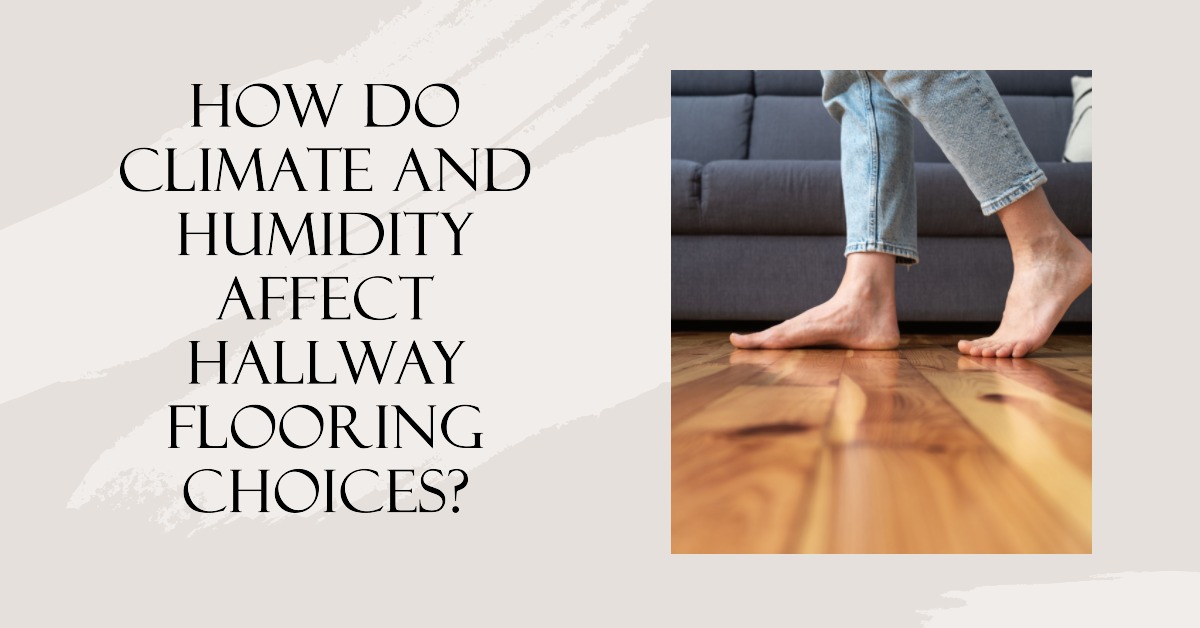
Climate and humidity can have a significant impact on your choice of hallway flooring. Here’s how:
- Hardwood: Solid hardwood can expand and contract with changes in humidity, making it less suitable for areas with significant fluctuations.
- Engineered Wood: Engineered wood is less sensitive to changes in humidity and temperature, making it a more stable option.
- Laminate: Generally stable under varying climatic conditions, although it can be susceptible to moisture damage.
- Vinyl (LVT): Highly resilient to humidity and temperature changes, making it suitable for virtually all climates.
- Tile: Ceramic and porcelain tiles are unaffected by humidity, making them an excellent option for damp climates.
- Stone: Natural stone is also highly resistant to climatic changes but may require sealing to prevent moisture absorption.
- Carpet: Not recommended for damp climates due to the potential for mould and mildew.
- Cork: Sensitive to humidity changes and may require a dehumidifier in damp climates.
- Bamboo: Relatively stable but can be susceptible to extreme changes in humidity.
- Rubber: Highly resilient and suitable for all climates, although some types may be susceptible to UV damage if exposed to direct sunlight.
| Flooring Type | Sensitivity to Humidity | Sensitivity to Temperature | Suitability in Damp Climates |
|---|---|---|---|
| Hardwood | High | Moderate | Low |
| Engineered Wood | Low | Low | High |
| Laminate | Moderate | Low | Moderate |
| Vinyl (LVT) | Low | Low | High |
| Tile | Low | Low | High |
| Stone | Low | Low | High |
| Carpet | High | Low | Low |
| Cork | High | Low | Moderate |
| Bamboo | Moderate | Moderate | Moderate |
| Rubber | Low | Low | High |
What Is the Lifespan of Different Hallway Flooring Options?
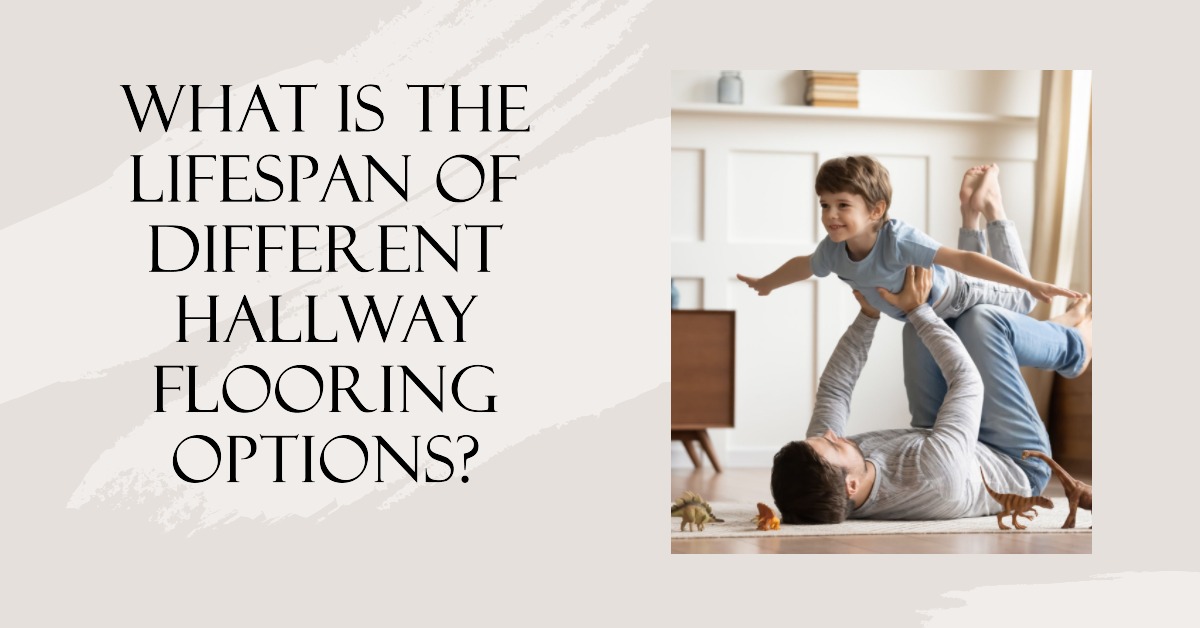
The longevity of your flooring investment is another crucial factor to consider. Here’s a breakdown of the expected lifespan of different types of flooring:
- Hardwood: Can last upwards of 50 years if properly maintained, including periodic refinishing.
- Engineered Wood: Generally lasts 20 to 30 years, although high-quality options with thicker wear layers can last longer.
- Laminate: On average, lasts about 15 to 25 years depending on the quality and maintenance.
- Vinyl (LVT): Can last 20 to 25 years if well maintained, making it a durable option.
- Tile: Both ceramic and porcelain tiles can last 50 years or more, making them one of the most durable options.
- Stone: With proper care, natural stone can last a lifetime.
- Carpet: Typically lasts 5 to 15 years, depending on the quality and maintenance.
- Cork: Can last between 20 to 30 years if properly sealed and maintained.
- Bamboo: Generally lasts 20 to 25 years with proper care.
- Rubber: Highly durable and can last 20 years or more with proper maintenance.
| Flooring Type | Expected Lifespan (years) | Refinishing Required? |
|---|---|---|
| Hardwood | 50+ | Yes |
| Engineered Wood | 20 – 30 | Occasionally |
| Laminate | 15 – 25 | No |
| Vinyl (LVT) | 20 – 25 | No |
| Tile | 50+ | No |
| Stone | Lifetime | Occasionally |
| Carpet | 5 – 15 | No |
| Cork | 20 – 30 | Yes |
| Bamboo | 20 – 25 | Occasionally |
| Rubber | 20+ | No |
How Do I Choose Flooring Material Based on Foot Traffic in the Hallway?
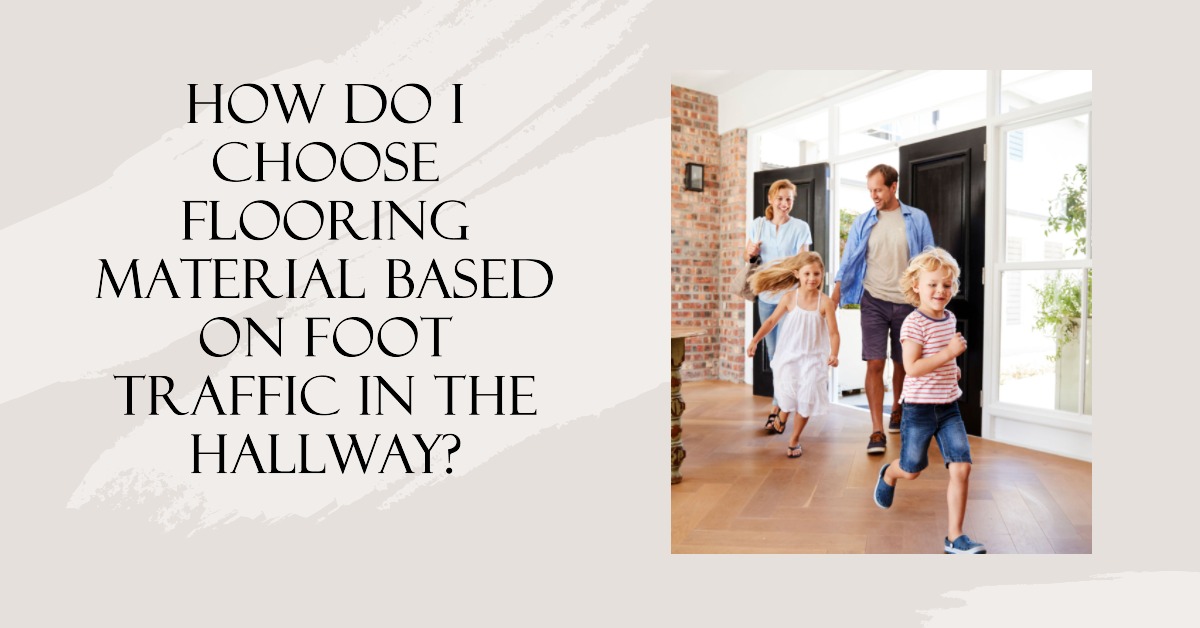
Foot traffic in your hallway plays a substantial role in determining the most suitable flooring material.
- Hardwood: Suitable for moderate to high foot traffic, especially when you choose a hard species like oak or cherry.
- Engineered Wood: Excellent for moderate to high foot traffic, particularly types with thicker wear layers.
- Laminate: Designed to withstand high foot traffic, making it an excellent choice for busy households.
- Vinyl (LVT): Also excellent for high foot traffic areas and offers the benefit of cushioning underfoot.
- Tile: Extremely durable and ideal for high-traffic areas, though its hardness may be a concern.
- Stone: Similar to tile in its suitability for high traffic areas but with a more luxurious appearance.
- Carpet: Best suited for low to moderate traffic areas due to its susceptibility to wear and tear.
- Cork: Suitable for moderate traffic but may require more frequent maintenance.
- Bamboo: Good for moderate to high foot traffic, depending on the hardness rating.
- Rubber: Ideal for high-traffic areas and commercial settings, offering durability and ease of maintenance.
| Flooring Type | Suitability for Low Traffic | Suitability for Moderate Traffic | Suitability for High Traffic |
|---|---|---|---|
| Hardwood | Good | Excellent | Excellent |
| Engineered Wood | Good | Excellent | Excellent |
| Laminate | Good | Excellent | Excellent |
| Vinyl (LVT) | Good | Excellent | Excellent |
| Tile | Excellent | Excellent | Excellent |
| Stone | Excellent | Excellent | Excellent |
| Carpet | Excellent | Moderate | Poor |
| Cork | Moderate | Good | Moderate |
| Bamboo | Good | Excellent | Excellent |
| Rubber | Good | Excellent | Excellent |
What Is the Installation Process Like for Different Types of Flooring?
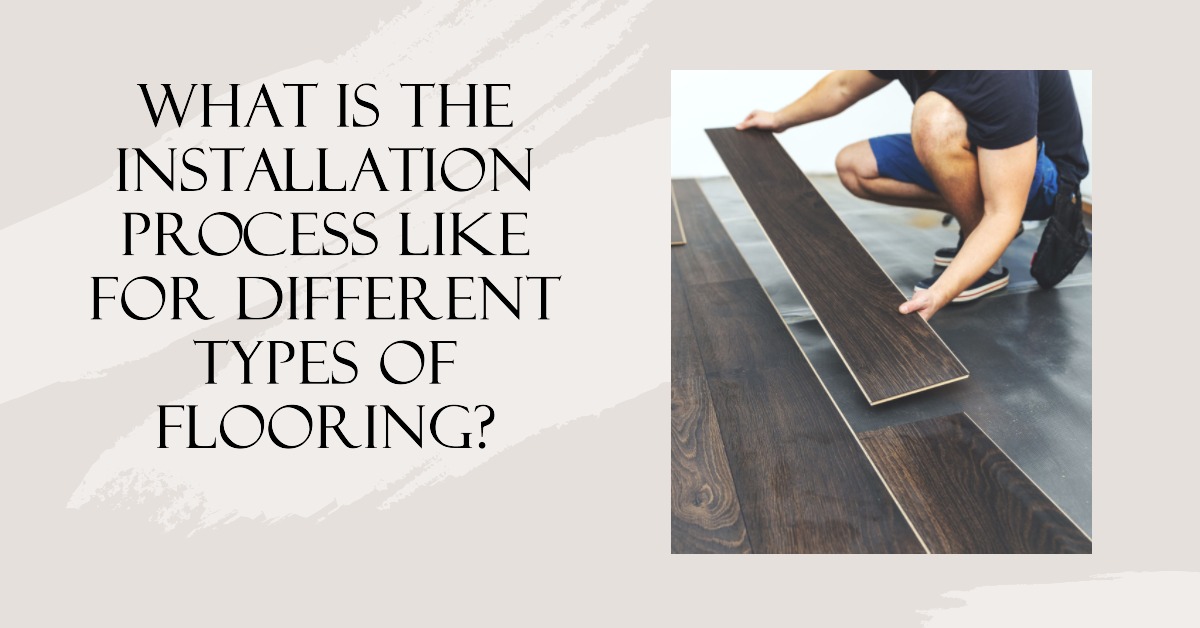
Understanding the installation process for various types of flooring can help you plan better and potentially save on costs.
- Hardwood: Typically installed via nailing or stapling, and it requires a wood subfloor. The process is labor-intensive and may require professional installation.
- Engineered Wood: Can be floated, glued, or nailed down. It’s generally easier and quicker to install than hardwood.
- Laminate: Usually installed with a click-lock system and can be floated over an existing floor, making it a DIY-friendly option.
- Vinyl (LVT): Comes in peel-and-stick, click-lock, or glue-down options. Generally easy to install.
- Tile: Requires a cement backer board subfloor and the application of mortar. Professional installation is often recommended.
- Stone: Similar to tile in terms of installation but may require additional structural support due to its weight.
- Carpet: Needs a carpet pad and is generally tacked or stapled down. Professional installation is usually advised.
- Cork: Comes in click-lock or glue-down options. Can generally be installed over an existing floor.
- Bamboo: Similar to hardwood in terms of installation methods.
- Rubber: Usually comes in tiles or rolls and can be loose-laid, glued, or interlocked.
| Flooring Type | Installation Method | DIY-Friendly |
|---|---|---|
| Hardwood | Nail/Staple | No |
| Engineered Wood | Float/Nail/Glue | Moderate |
| Laminate | Click-Lock | Yes |
| Vinyl (LVT) | Peel-and-Stick/Click/Glue | Yes |
| Tile | Mortar | No |
| Stone | Mortar | No |
| Carpet | Tack/Staple | No |
| Cork | Click-Lock/Glue | Moderate |
| Bamboo | Nail/Staple | No |
| Rubber | Loose/Glue/Interlock | Yes |
Can I Use Underfloor Heating With All Types of Hallway Flooring?
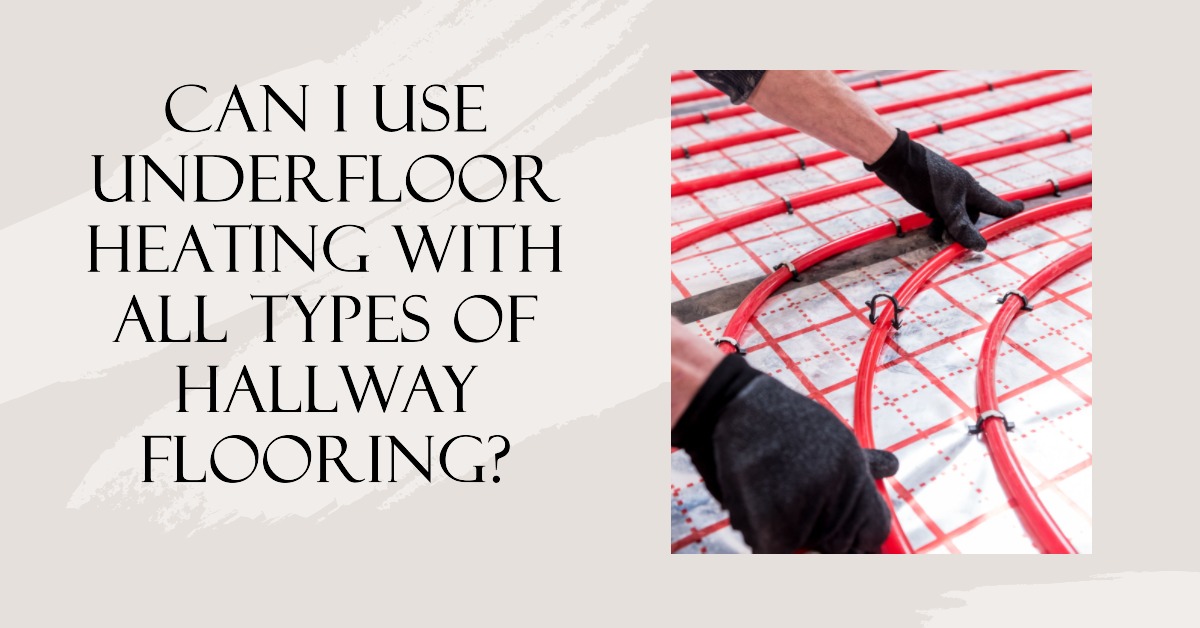
Underfloor heating is a luxurious feature many homeowners consider. However, not all flooring types are compatible.
- Hardwood: Generally not recommended due to the potential for warping.
- Engineered Wood: More stable with underfloor heating compared to hardwood but consult the manufacturer for specific guidelines.
- Laminate: Suitable for underfloor heating, but it’s essential to follow the manufacturer’s instructions.
- Vinyl (LVT): Compatible, but the temperature should be regulated to prevent damage.
- Tile and Stone: Excellent conductors of heat, making them ideal for underfloor heating.
- Carpet: Possible, but the carpet should be low-pile and the heating system low-temperature.
- Cork: Suitable but consult the manufacturer’s guidelines.
- Bamboo: Generally compatible but consult the manufacturer.
- Rubber: Not commonly used with underfloor heating.
| Flooring Type | Compatibility with Underfloor Heating |
|---|---|
| Hardwood | Not Recommended |
| Engineered Wood | Consult Manufacturer |
| Laminate | Suitable |
| Vinyl (LVT) | Suitable |
| Tile | Excellent |
| Stone | Excellent |
| Carpet | Possible |
| Cork | Consult Manufacturer |
| Bamboo | Consult Manufacturer |
| Rubber | Not Common |
How Do Design and Aesthetics Come Into Play?

The design and aesthetic value of the flooring you choose can greatly influence the overall feel of your hallway. Here’s how each flooring type fares:
- Hardwood: Offers a timeless, classic look and can be stained to suit any décor.
- Engineered Wood: Provides the look of hardwood but with more options for finishes and textures.
- Laminate: Available in a wide range of patterns and styles, including wood-look and stone-look options.
- Vinyl (LVT): Offers the most variety in terms of patterns, including realistic wood and stone effects.
- Tile: Allows for intricate designs and patterns, especially with the use of different colours and shapes.
- Stone: Provides a luxurious, natural look but is generally more limited in terms of colour options.
- Carpet: Offers a cozy feel and comes in various patterns and colours.
- Cork: Provides a unique, natural aesthetic.
- Bamboo: Offers a modern, clean look.
- Rubber: Generally more utilitarian in appearance but available in various colours and patterns.
What Are the Latest Trends in Hallway Flooring?
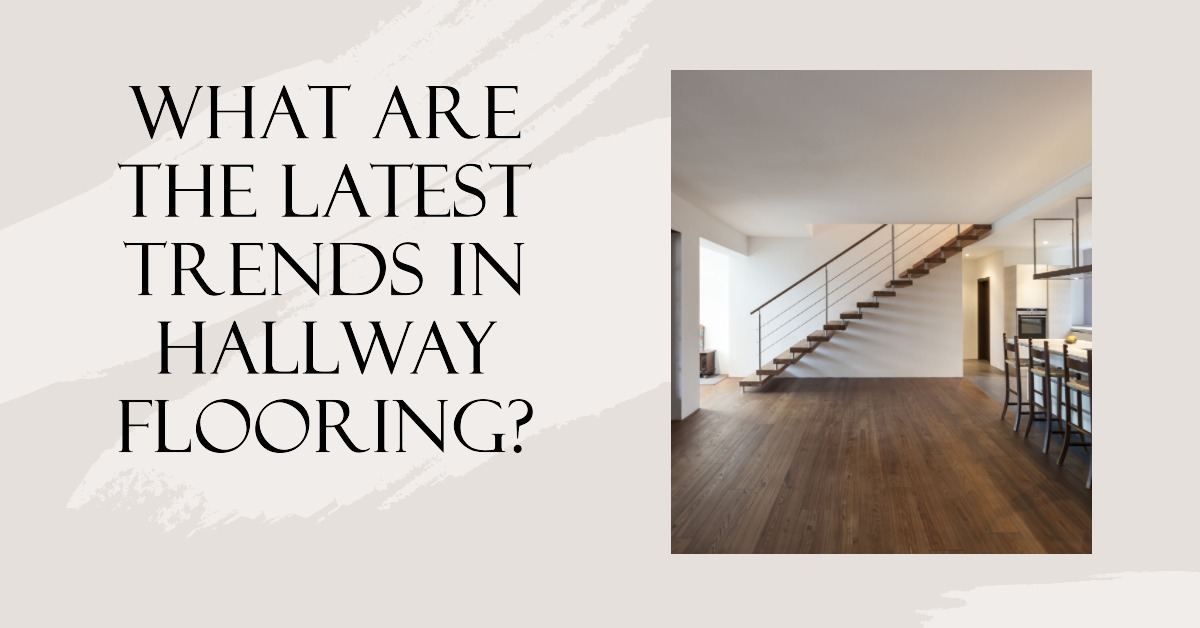
Keeping up with the latest trends can add a contemporary touch to your hallway. Some of the current trends include:
- Wide Plank Hardwood: Offers a modern twist to traditional hardwood floors.
- Textured Finishes: Engineered wood and laminates with hand-scraped or wire-brushed finishes are gaining popularity.
- Geometric Patterns: Especially popular in tile installations.
- Luxury Vinyl Plank: Mimics the look of natural materials, offering a blend of affordability and style.
- Natural Stone: Slate and travertine are particularly popular for an upscale, organic look.
- Sustainable Options: Cork and bamboo flooring are on the rise due to their eco-friendliness.
- Vivid Colours: Particularly in rubber flooring for a bold, modern statement.
- Layered Area Rugs: Over hard flooring types for added warmth and texture.
- Matte Finishes: Across all flooring types for a softer, more natural look.
- Smart Flooring: With integrated heating or lighting elements.
Make Your Hallway a Statement with Wood and Beyond
As you’ve seen, choosing the right flooring for your hallway is a nuanced decision that involves a range of factors. Whether you’re concerned about durability, maintenance, or the sheer aesthetic appeal, Wood and Beyond has a solution for you. With our superior range of Hardwood, Engineered Wood, Laminate, and Luxury Vinyl Flooring, you can make a statement that lasts. Discover flooring options that not only meet but exceed your expectations, ensuring your hallway stands the test of time—both in durability and style. Choose Wood and Beyond for your next home improvement project—you won’t be disappointed.
—
FAQ
What Types of Flooring Are Best for Durability in Hallways?
When it comes to durability, hardwood options such as oak, maple, and hickory rank highest for withstanding heavy traffic in hallways. Engineered wood is also a robust choice, being less prone to damage from fluctuations in humidity and temperature. Luxury Vinyl Tiles (LVT) and certain types of tiles like ceramic and porcelain offer good durability as well.
Which Flooring Options Are Recommended for Households with Pets and Children?
If you have a bustling household with pets and children, consider flooring options that are scratch-resistant and easy to clean. Hardwoods like Brazilian cherry and engineered wood with thick wear layers are good choices. Luxury Vinyl Tiles (LVT) and laminate flooring are also good options for their scratch-resistant properties and ease of maintenance.
How Long Can I Expect Different Types of Hallway Flooring to Last?
The lifespan of your hallway flooring depends on the material and proper maintenance. For instance, hardwood can last up to 50 years with proper care, while engineered wood lasts around 20 to 30 years. Luxury Vinyl Tiles (LVT) and laminate flooring have a lifespan of approximately 20 to 25 years.
What Are the Most Trending Choices in Hallway Flooring?
Current trends in hallway flooring include wide plank hardwood for a modern aesthetic and textured finishes in engineered wood and laminate. Other fashionable options include geometric tile patterns, natural stone like slate and travertine, and sustainable materials like cork and bamboo.
Are There Eco-Friendly Flooring Options Available?
Yes, there are several eco-friendly flooring options available for hallways. Cork and bamboo are both sustainable choices. Cork has the added benefit of being naturally antimicrobial and soft underfoot, whereas bamboo is known for its hardness, although it can be prone to scratches and dents.








